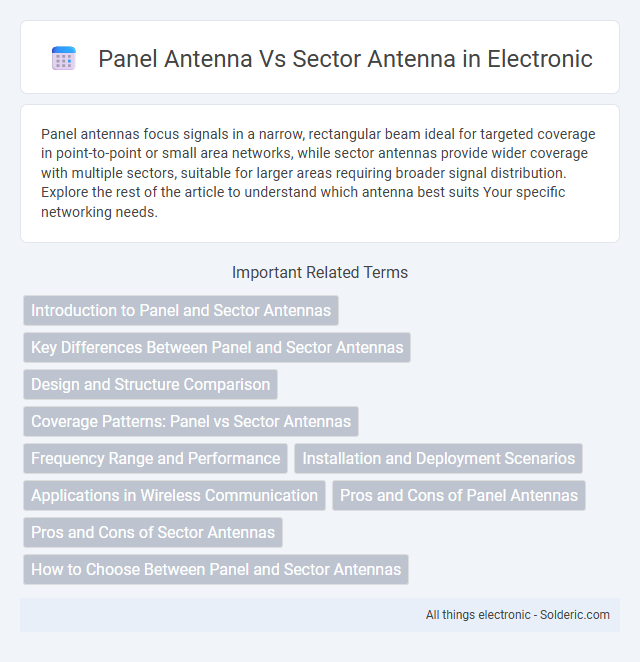Panel antennas focus signals in a narrow, rectangular beam ideal for targeted coverage in point-to-point or small area networks, while sector antennas provide wider coverage with multiple sectors, suitable for larger areas requiring broader signal distribution. Explore the rest of the article to understand which antenna best suits Your specific networking needs.
Comparison Table
| Feature | Panel Antenna | Sector Antenna |
|---|---|---|
| Radiation Pattern | Directional, narrow beam | Directional, wide coverage (typically 60deg to 120deg sectors) |
| Typical Gain | 8-16 dBi | 10-18 dBi |
| Use Case | Point-to-point links, focused coverage areas | Cellular base stations, wide area coverage within sector ranges |
| Beamwidth | Narrow (around 30deg horizontal) | Wide (typically 60deg to 120deg horizontal) |
| Installation | Requires precise alignment | Fixed orientation to cover specific sector |
| Application | WiFi backhaul, point-to-point wireless bridges | 4G/5G cellular networks, wireless ISPs |
Introduction to Panel and Sector Antennas
Panel antennas and sector antennas serve distinct roles in wireless communication by focusing signal propagation. Panel antennas typically provide a narrow, fixed beamwidth suitable for targeted coverage, while sector antennas offer a wider beamwidth to cover broader areas, often used in cellular networks. Understanding the coverage pattern and gain characteristics of these antennas helps optimize Your network design for specific deployment scenarios.
Key Differences Between Panel and Sector Antennas
Panel antennas provide a narrow, focused beam ideal for point-to-point communication, while sector antennas cover a wider area with multiple sectors, suited for point-to-multipoint applications. Sector antennas typically offer 60 to 120 degrees of horizontal coverage, enhancing network capacity by serving multiple users simultaneously, whereas panel antennas focus on a single direction with higher gain. Your choice depends on whether you need targeted signal strength or broad area coverage for your wireless network.
Design and Structure Comparison
Panel antennas feature a flat, rectangular design optimized for focused signal transmission with a narrow beamwidth, making them ideal for point-to-point communication. Sector antennas have a fan-shaped structure that provides a wider azimuth coverage, typically ranging from 60 to 120 degrees, suitable for cellular and wireless network sectorization. The design of panel antennas emphasizes high gain and directionality, while sector antennas balance coverage area and gain to serve multiple users within a defined sector.
Coverage Patterns: Panel vs Sector Antennas
Panel antennas provide a narrow, focused coverage pattern typically ranging from 60deg to 120deg, making them ideal for point-to-point or targeted coverage areas. Sector antennas offer wider coverage patterns usually between 90deg and 120deg, which allows for efficient deployment in cellular base stations covering broad sectors or multiple users. The choice between panel and sector antennas depends on required coverage breadth, signal strength, and network topology.
Frequency Range and Performance
Panel antennas typically operate within a frequency range of 698 MHz to 2700 MHz, offering stable directional coverage ideal for cellular and Wi-Fi applications. Sector antennas cover similar frequencies but are optimized for wider horizontal beamwidths, enhancing performance in multi-sector cellular networks by supporting multiple users simultaneously. Choosing between the two depends on your need for focused high-gain coverage (panel) versus broader area coverage with moderate gain (sector).
Installation and Deployment Scenarios
Panel antennas are typically easier to install and deploy in compact or indoor environments due to their flat, rectangular design, making them ideal for targeted coverage in smaller areas. Sector antennas offer broader horizontal coverage, often used in outdoor scenarios like cellular base stations where multiple antennas are mounted on towers to cover expansive sectors. Your choice depends on the deployment scenario: panel antennas suit confined spaces with precise directionality, while sector antennas excel in wide-area, outdoor installations requiring high capacity.
Applications in Wireless Communication
Panel antennas are commonly used in point-to-point wireless communication links due to their narrow beamwidth and high gain, making them ideal for long-distance data transmission. Sector antennas are preferred in cellular networks and Wi-Fi deployments to cover wide areas by dividing coverage into multiple sectors, improving capacity and reducing interference. Both antenna types play crucial roles in optimizing network coverage, capacity, and performance in various wireless communication applications.
Pros and Cons of Panel Antennas
Panel antennas offer a focused, narrow beamwidth ideal for point-to-point or point-to-multipoint communication, providing high gain and reduced interference. They are compact, easy to mount, and suitable for environments where signal directionality enhances performance, but their limited coverage angle can require multiple units for broader area coverage. Your choice depends on the need for precision targeting versus wider signal distribution, as panel antennas excel in controlled, directional applications but may not serve large, dispersed networks efficiently.
Pros and Cons of Sector Antennas
Sector antennas provide wide coverage with a typical horizontal beamwidth of 60 to 120 degrees, making them ideal for serving multiple users across a specific area. Their design supports high gain and focused signal distribution, enhancing network capacity and range in cellular and Wi-Fi deployments. However, sector antennas can introduce interference between adjacent sectors if not properly aligned, and they may require more complex installation and configuration compared to panel antennas.
How to Choose Between Panel and Sector Antennas
Choosing between panel and sector antennas depends on coverage area, beamwidth, and installation environment. Panel antennas provide narrow beamwidths ideal for point-to-point communication and focused coverage, while sector antennas offer wider beamwidths suited for broad area coverage in cellular or Wi-Fi networks. Consider factors such as desired coverage radius, mounting location, frequency band, and signal gain requirements to determine the optimal antenna type for your wireless network application.
panel antenna vs sector antenna Infographic

 solderic.com
solderic.com